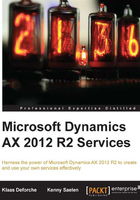
The SysOperation framework
Prior to Microsoft Dynamics AX 2012, the RunBase framework was used to provide a generic way to create processes and batch jobs in the system.
In Microsoft Dynamics AX 2012, the SysOperation framework allows you to leverage the power of services to execute your business logic in Microsoft Dynamics AX. When you create a service, it encapsulates the business logic so other components within the system can use the service instead of accessing the business logic themselves.
The SysOperation framework makes use of the Model-view-controller (MVC) pattern by using multiple components that each have their own responsibilities. These components separate the business logic from the code that is responsible for rendering the GUI and the classes that represent the data model. This is a great leap forward from Microsoft Dynamics AX 2009, where everything was written in one class that extended Runbase.
Also important to note is that, when a service has been created for the SysOperation framework, it requires little effort to expose the same service to the outside world. You can simply expose it using an integration port.
So the advantages of the SysOperation framework can be summarized as follows:
- It facilitates a service-oriented approach within Microsoft Dynamics AX
- It implements the MVC pattern for more efficient client/server communication and separation of responsibilities
- The GUI is automatically generated based on data contracts
- Less effort in exposing business functionality externally using services